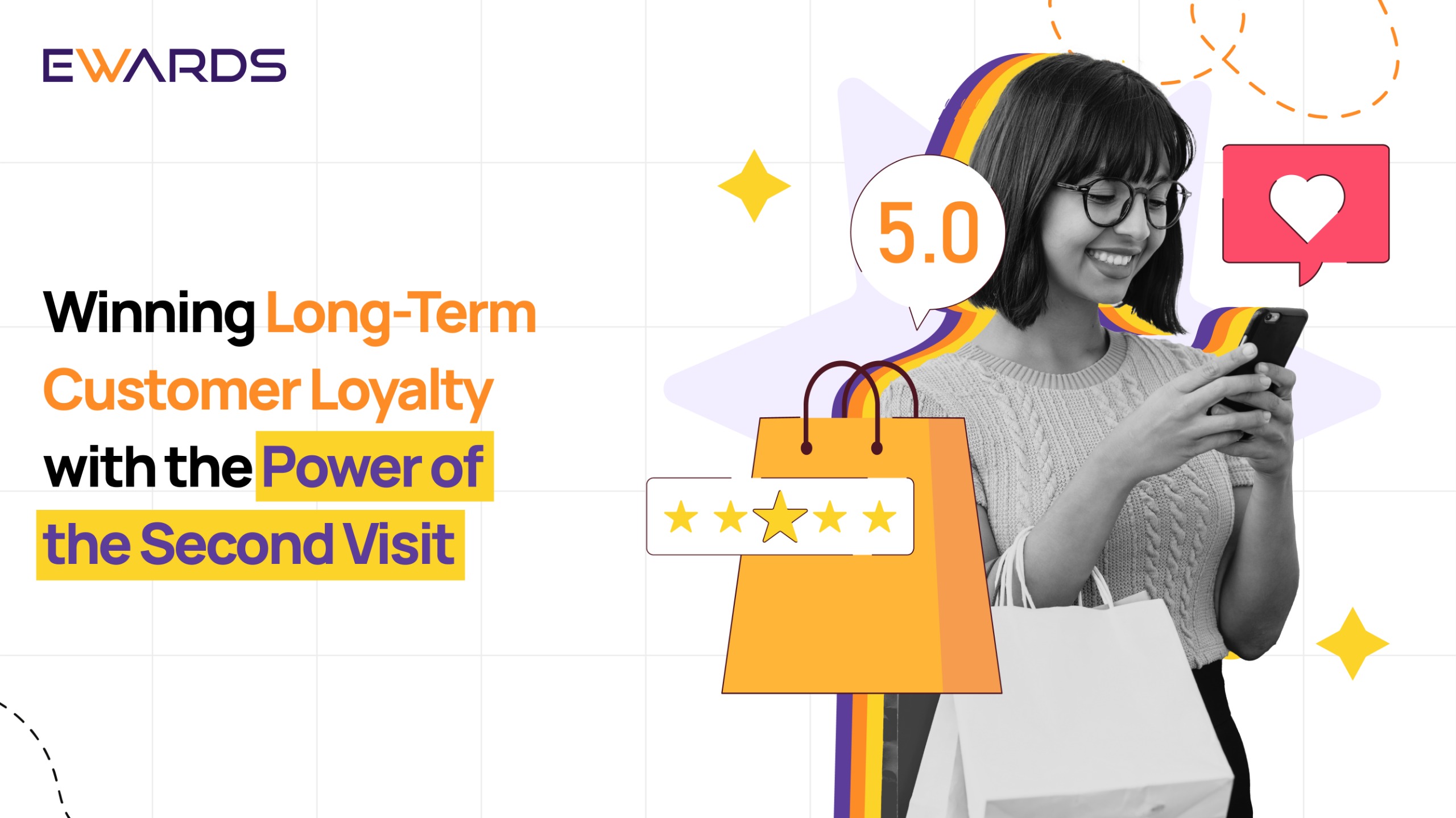
Imagine this: a customer walks into your store, browses your products, maybe even makes a purchase, and then—nothing. They don’t come back. How many times have you experienced this? The truth is, 80% of sales happen between the fifth to twelfth interactions. But here’s the kicker: 48% of salespeople never even follow up after the first visit.
According to SAP Emarsys, repeat customers spend 67% more than new customers. But why is that second visit so powerful? And how can you harness it to drive customer loyalty and revenue growth?
This article dives deep into why the second visit is crucial, how to incentivize it, and the strategies that will help you convert first-time visitors into lifelong brand advocates.
What is the Second Visit & Why Does It Matter?
The second visit is the crucial tipping point where a potential customer transitions from a first-time browser to a loyal brand advocate. It’s the moment a one-time buyer has the opportunity to turn into a repeat customer. But why is this second visit so powerful, and how can it impact your business?
According to Harvard Business Review, acquiring a new customer costs 5 times more than retaining an existing one. That’s why the second visit is not just a chance—it’s a golden opportunity to establish a long-term relationship with the customer. A strong second visit not only boosts your chances of customer retention but also significantly increases customer lifetime value (CLV). In fact, research by Bain & Co. shows that a 5% increase in customer retention can lead to a 25%-95% increase in profits.
Why does it matter?
- Higher Conversion Rate – According to SEMRush statistics, after buying for the first time, a customer has a 27% chance of buying again. Simply put, with a second interaction, the customer becomes much more comfortable and trusting of your brand.
- Improved Customer Loyalty: A loyal customer is a repeat customer. Data from Epsilon shows that 80% of consumers are more likely to buy from a brand that offers a personalized experience. A strong second visit reinforces that loyalty and brings customers back again and again.
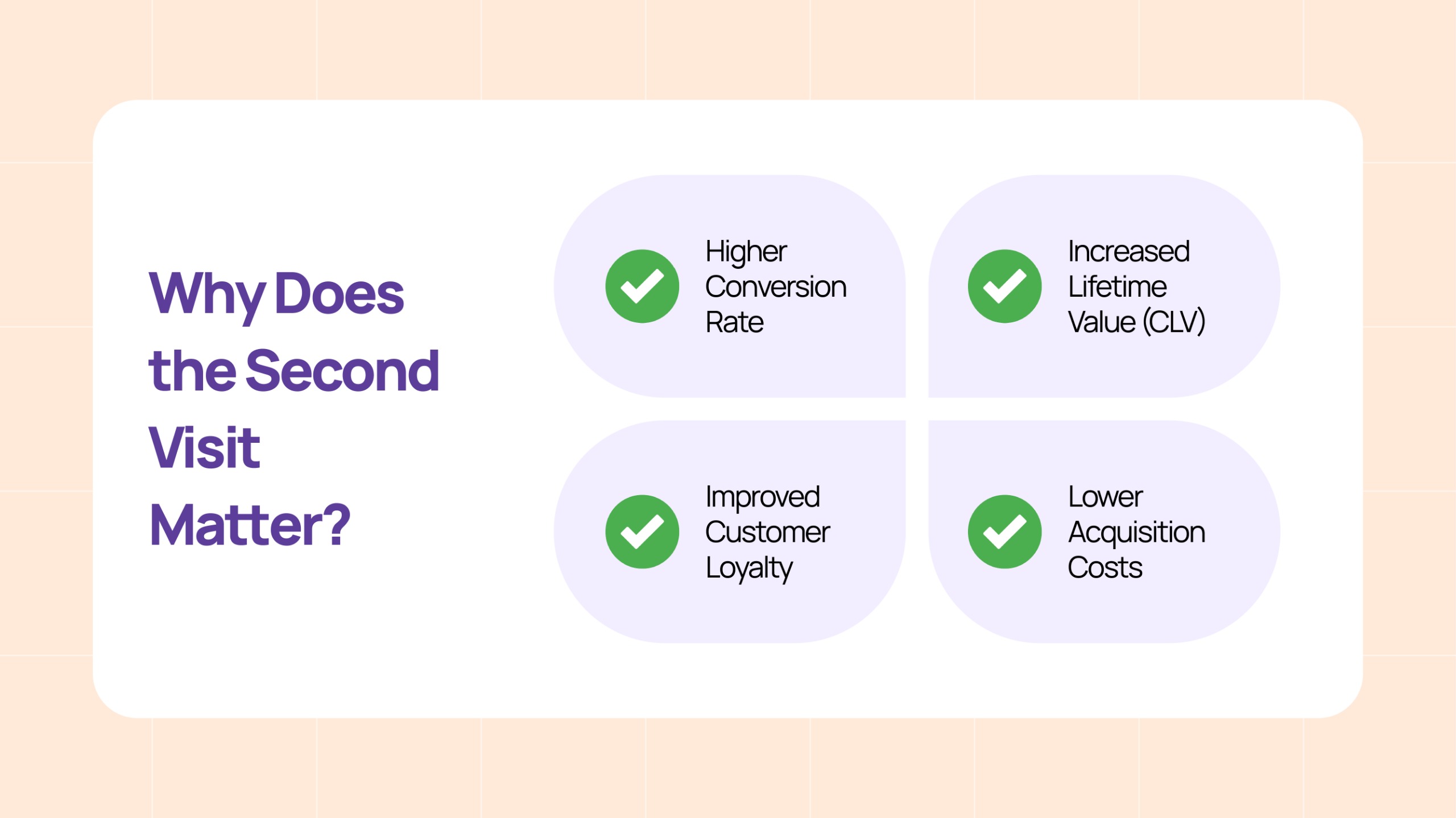
- Increased Lifetime Value (CLV): Customers who return after their first purchase have a much higher potential for long-term value. They are more likely to make higher-value purchases, refer others to your brand, and remain loyal over time. For instance, repeat customers contribute to 40% of total revenue, even though they make up just 8% of the customer base (Growwave).
- Lower Acquisition Costs: With the second visit, the need for expensive customer acquisition strategies is reduced. Engaging existing customers costs significantly less than attracting new ones, and a focused effort on converting first-time buyers to repeat customers yields much higher ROI.
The second visit is often the point where customers decide whether they’ll continue to engage with your brand or move on to competitors. Fostering the second visit is an essential part of a successful retention strategy that drives repeat business, increases customer lifetime value, and ensures long-term brand loyalty.
Challenges of Getting That Second Visit
Despite the clear benefits, many businesses struggle to get customers to come back after the first visit. It’s easy to assume that a sale made is a sale retained, but the statistics don’t lie. Many brands fail to create the right experience, and the customer’s interest fades away.
Some of the common challenges for getting that second visit include:
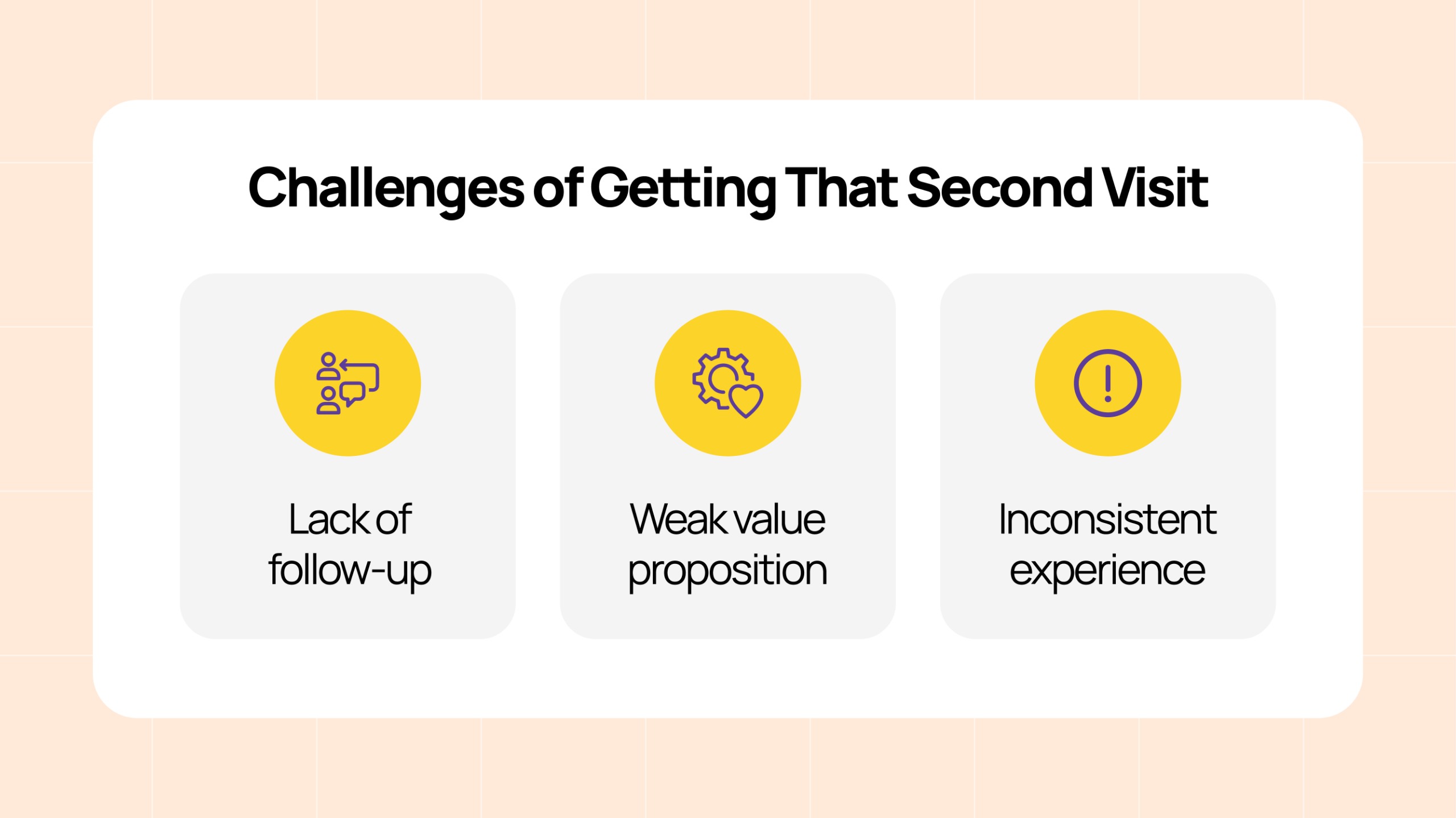
- Lack of follow-up: Without post-purchase communication, customers forget about their first experience with the brand.
- Weak value proposition: If the customer didn’t feel a strong emotional connection to the brand or product, they may not feel compelled to come back.
- Inconsistent experience: If customers experience inconsistency in their first visit (whether online or offline), they’re less likely to return.
How the Second Visit Can Change Your CRM Strategy?
Incorporating the concept of the second visit into your CRM strategy is one of the most effective ways to foster customer loyalty, increase repeat purchases, and maximize customer lifetime value. The second visit is a pivotal moment in the customer journey, and tailoring your CRM efforts around this stage can yield long-lasting benefits.
Let’s look at how this shift in focus can reshape your CRM approach.
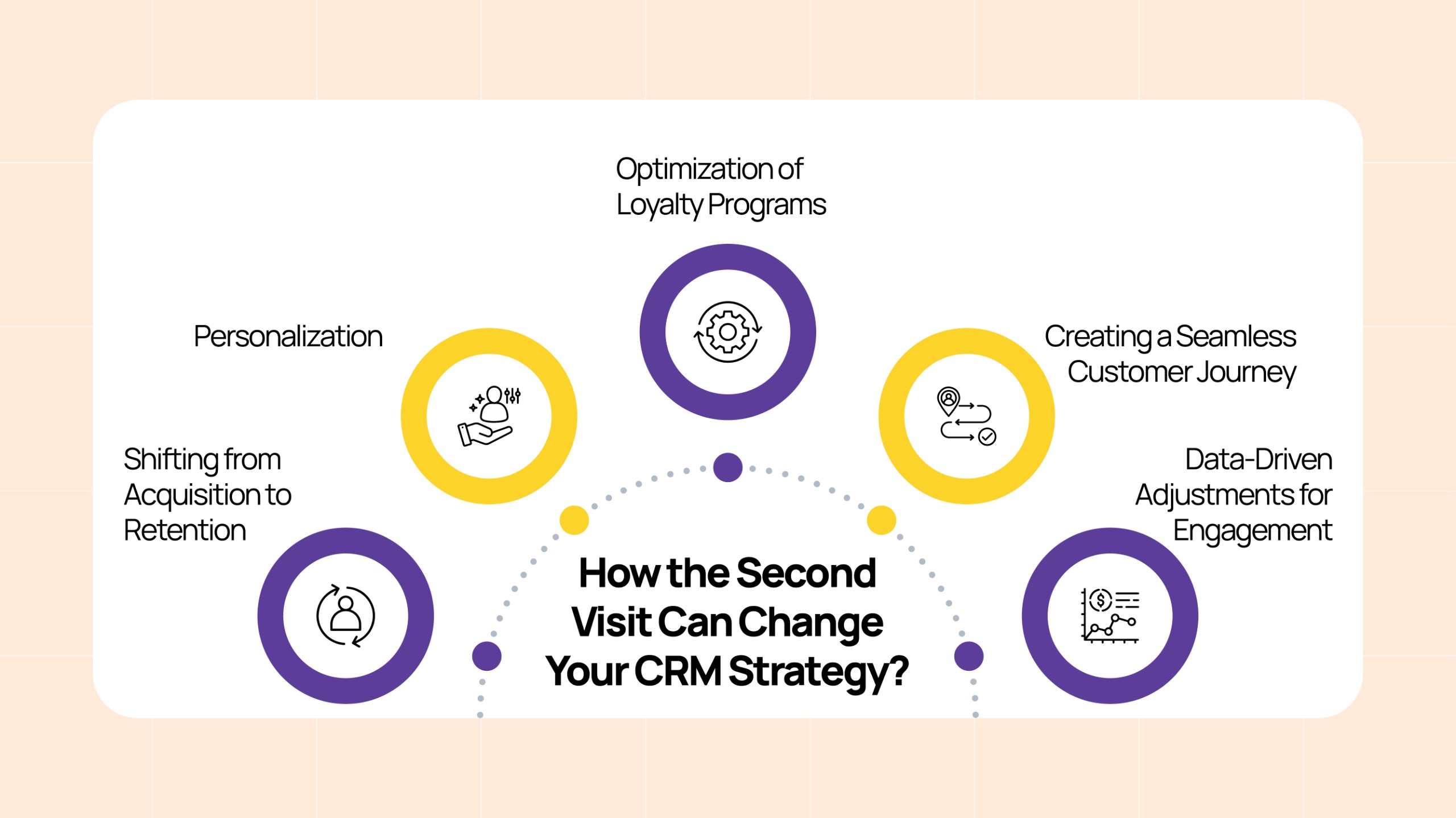
- Shifting from Acquisition to Retention
Most traditional CRM strategies focus heavily on acquiring new customers, often at the cost of nurturing existing ones. But what if you could shift that focus to retention by optimizing the second visit? The second visit is a clear indicator of customer intent to stay engaged with your brand. Once a customer returns for that second interaction, they’ve shown a higher likelihood of becoming a repeat buyer, and this is where CRM systems can be most valuable.
Instead of pushing for constant customer acquisition campaigns, a CRM strategy designed around repeat business focuses on:
- Tracking first-time buyers and ensuring a seamless transition into the second visit.
- Sending targeted communications (emails, SMS, app notifications) that encourage this transition.
- Segmentation based on first-time buyers to personalize messages that align with their buying behavior.
- Personalization
The second visit provides the perfect opportunity to tailor experiences to individual customers. With data gathered from the first interaction, CRM tools can enable brands to craft personalized messages, offers, and reminders.
For example:
- Behavior-based triggers can prompt the system to send a follow-up message after a customer’s first purchase or after a certain period of inactivity.
- Automated recommendations based on past behavior (i.e., suggesting products that complement the items they previously purchased) make the experience feel more tailored, increasing the chances of conversion during the second visit.
- Optimization of Loyalty Programs
Integrating the second visit into your loyalty programs can significantly boost customer retention. According to research, 80 percent of customers who have joined a loyalty program have a 60 percent chance of making a recurring purchase. Your CRM system can trigger loyalty program offers right after the first purchase to increase the likelihood of that return visit.
For example:
- Reward-based campaigns, such as offering loyalty points for making a second purchase, can be automatically triggered after the first transaction.
- Exclusive discounts or early access to sales for the second visit can be part of a more personalized loyalty experience that draws the customer back to your store or website.
- Creating a Seamless Customer Journey
The second visit should feel like a natural continuation of the first interaction. By implementing CRM automation tools, brands can ensure that the customer experience is seamless and easy to navigate, increasing the chances of that second visit happening. This can include:
- Automated reminders via email or push notifications at an optimal time after the first visit.
- Quick re-engagement through cart recovery: CRM systems can automatically remind customers about abandoned carts or unfinished purchases, making it easy for them to return and complete the transaction.
- Data-Driven Adjustments for Engagement
Once customers return for the second visit, you have a wealth of data to work with. By using CRM analytics, you can track patterns such as:
- Which offers led to a second visit?
- What kind of products do customers buy after their first purchase?
- How does customer behavior change between the first and second visit?
These insights can be used to fine-tune your CRM strategy. By analyzing customer data, businesses can continuously optimize engagement strategies, tweak product recommendations, and refine messaging to make future second visits more likely.
How Nike Can Use CRM for Nurturing a Second Visit?
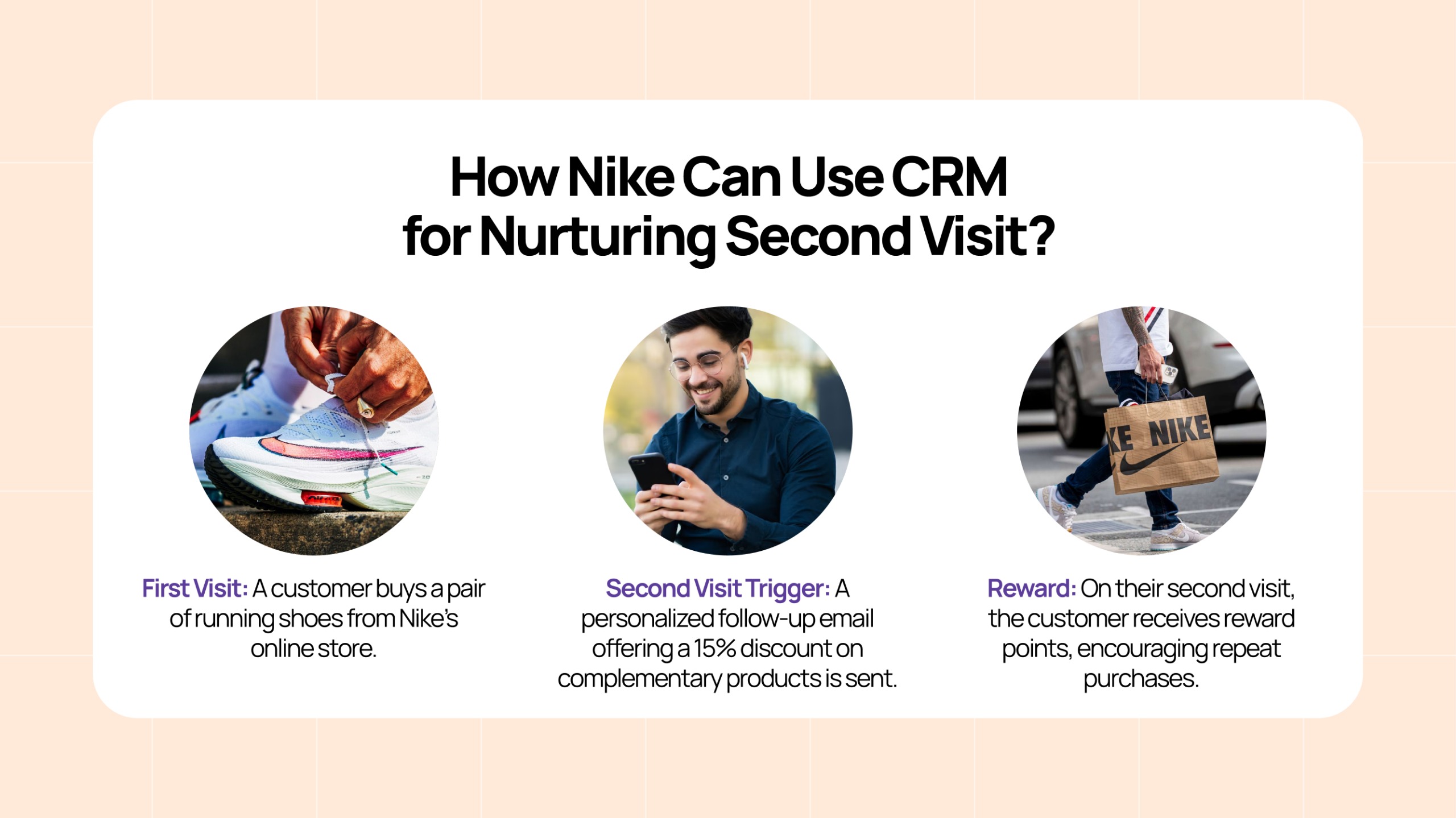
Let’s take a look at how a well-known retail brand can use CRM tools to nurture that second visit:
- First Visit: A customer buys a pair of running shoes from Nike’s online store.
- Second Visit Trigger: Nike’s CRM system recognizes the first-time purchase and sends a personalized follow-up email a week later. The email offers a 15% discount on complementary products (e.g., running apparel) or invites them to a local store event.
- Reward: On their second visit (whether in-store or online), the customer receives reward points for their next purchase, further encouraging repeat purchases.
In this scenario, Nike’s CRM strategy is tailored to leverage the second visit as a key moment for strengthening customer relationships and building loyalty.
Why CRM Strategies Built Around Second Visits Matter?
The cost of customer acquisition is high, hence, your CRM strategy needs to evolve beyond just acquiring new customers. By focusing on the second visit, brands can maximize customer retention, build stronger relationships, and ultimately enhance profitability.
Benefits of Focusing on the Second Visit in CRM:
- Higher conversion rates occur as customers become more familiar with your brand.
- Improved customer loyalty through personalized touchpoints and reward systems.
- More cost-effective marketing, as retaining a customer is significantly cheaper than acquiring a new one.
Conclusion
The second visit is a powerful moment in the customer journey, offering brands a unique opportunity to build long-term relationships. By embedding second-visit-focused strategies into your CRM system, you’ll be able to increase customer retention, enhance lifetime value, and cultivate a loyal customer base that keeps coming back for more.
It’s time to shift your focus from one-off transactions to creating repeat interactions. Optimize your CRM for the second visit and unlock the full potential of customer loyalty.
Let’s connect and explore how we can help you integrate second-visit strategies into your CRM system for long-lasting success!